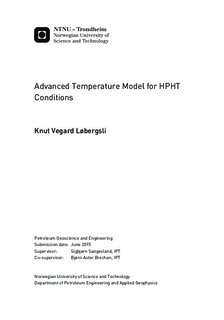Advanced Temperature Model for HPHT Conditions
Master thesis
Permanent lenke
http://hdl.handle.net/11250/2351041Utgivelsesdato
2015Metadata
Vis full innførselSamlinger
Sammendrag
Temperature changes of wells are analyzed in this Thesis. Wells need to be designed for all planned operations in order to maintain well integrity for the well life. Well barriers need to be numerically assessed for worst-case scenarios to ensure well integrity. However, when moving into harsh environment with high pressure and high temperature, the conventional methods for estimating the temperature in the well may be conservative.
There are softwares on the market today that account for these harsh conditions but they are not open source and does not give insight into the calculation. To figure out the effects of the input data and to learn more about the computation of the temperature distribution, a model was build and programmed in a simulation software.
In production cases, heat transfer is calculated radially for small length increments upwards along the wellbore. Thereby assuming steady state in the wellbore and transient state in the formation. A temperature distribution profile is based upon the heat transfer and the geothermal gradient of the formation. The results from the model are compared with industry leading simulation softwares.
The results of the various simulation softwares were found to be different. Sensitivity analysis of the input variables was conducted. Conductivity in tubing and casing is high, resulting in that the conductivity can be neglected in the calculations. It also shows the variation between different approximations of the dimensionless formation temperature is large at short duration of production and quite like at longer duration of production.
The effect of duration of production, production rate and various geothermal gradients is investigated. It is clear that caution should be obtained when deciding the geothermal gradient. Accurate characterization of the reservoir fluid is important since it influence the kinetic energy term and J-T effect, which again influence the temperature distribution.The impact of temperature on the thermal load is described. A high temperature at the wellhead gives a responding compression force, which can lead to higher risk of buckling.
Further improvements of the model are required. Pressure drops from friction and hydrostatic head as well as fluids phase behavior need to be added to make the model valid for multiphase flow.
